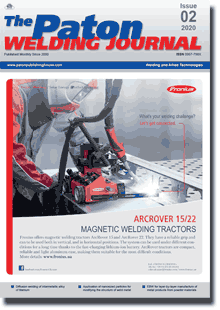| 2020 №02 (09) |
DOI of Article 10.37434/tpwj2020.02.01 |
2020 №02 (02) |

The Paton Welding Journal, 2020, #2, 2-8 pages
Formation of the structure and mechanical properties of joints of tialnb intermetallic alloy in diffusion welding
N.V. Piskun, Yu.V. Falchenko, L.V. Petrushinets, A.I. Ustinov, T.V. Melnichenko and I.I. Statkevich
E.O. Paton Electric Welding Institute of the NAS of Ukraine 11 Kazymyr Malevych Str., 03150, Kyiv, Ukraine. E-mail: office@paton.kiev.ua
Abstract
The impact of technological measures in vacuum diffusion welding on formation of the structure and mechanical properties of joints of TiAlNb intermetallic alloy was studied in the work. It is shown that welding of intermetallic alloy by the method of vacuum diffusion welding at temperature Tw = 1050 °C, pressure Pw = 10 MPa, for 20 min does not ensure producing sound joints. After welding, the joint line is visible in the butt, along which there is a considerable number of defects in the form of pore lines. Increase of welding parameters up to temperature Tw = 1200 °C, pressure Pw = 30 MPa, welding time of 30 min, as well as application of a ductile interlayer from NbTi alloy 1 mm thick allows improving the conditions of welded joint formation and greatly reducing the number of defects in the butt joint. During welding, common grains and diffusion zone 25–35 μm thick form between the interlayer material and the intermetallic alloy. Application of nanolayered interlayer of Al−Ti system of the total thickness of 25 μm in welding of TiAlNb intermetallic alloy, combined with cyclic loading in the form of 3 cycles of loading-unloading leads to a change of the nature of the structure in the joint zone. In the microstructures of welded joints obtained by optical metallography, the joint line is not visible. Application of electron microscopy allows detecting in the butt joint a diffusion zone 15 to 20 μm thick, close by its chemical composition to that of the intermetallic alloy. Investigation of the compressive strength of welded joints demonstrated that the average strength of joints of TiAlNb intermetallic alloy, produced using an interlayer from NbTi alloy, is equal to 988.2 MPa, and application of a nanolayered interlayer of Al–Ti system in welding allows increasing the average strength of the samples up to 1279.8 MPa. 16 Ref., 2 Tables, 8 Figures.
Keywords: TiAlNb intermetallic alloy, diffusion welding, interlayers, joint microstructure
Received 20.12.2019
References
1. Bochvar, G.A., Salenkov, V.A. (2004) Investigation of alloys based on titanium aluminide with orthorhombic structure. Tekhnologiya Lyogkikh Splavov, 4, 44-46 [in Russian].2. Clemens H., Mayer S. (2013) Design, Processing, Microstructure, Properties, and Applications of Advanced Intermetallic TiAl Alloys. Advanced Engineering Materials, 4. 191-215. https://doi.org/10.1002/adem.201200231
3. Huber D., Werner R., Clemens H., Stockinger M. (2015) Influence of process parameter variation during thermo-mechanical processing of an intermetallic β-stabilized γ-TiAl based alloy. Materials Characterization, 109, 116-121. https://doi.org/10.1016/j.matchar.2015.09.021
4. Godor F., Werner R., Lindemann J., Clemens H. (2015) Characterization of the high temperature deformation behavior of two intermetallic TiAl-Mo. Materials Science and Engineering: A, 648, 208-216. https://doi.org/10.1016/j.msea.2015.09.077
5. Appel F. Paul J.D.H., Oering M. (2011) Gamma Titanium Aluminide Alloys: Science and Technology. Weinheim, WILEY-VCH. https://doi.org/10.1002/9783527636204
6. Huang Z.W., Cong T. (2010) Microstructural instability and embrittlement behaviour of an Al-lean, high-Nb γ-TiAl-based alloy subjected to a long-term thermal exposure in air. Intermetallics, 18, 161-172. https://doi.org/10.1016/j.intermet.2009.07.007
7. Schwaighofer E., Clemens H., Mayer S. et al. (2014) Microstructural design and mechanical properties of a cast and heattreated intermetallic multi-phase γ-TiAl based alloy. Ibid, 44, 128-140. https://doi.org/10.1016/j.intermet.2013.09.010
8. Cam G., Ipekoglu G., Bohm K.-H., Kocak M. (2006) Investigation into the microstructure and mechanical properties of diffusion bonded TiAl alloys. J. of Materials Science, 16, 5273-5282. https://doi.org/10.1007/s10853-006-0292-4
9. Lei Zhu, Xiang-Yi Xue, Bin Tang et al. (2016) The Influence of Surface Roughness on Diffusion Bonding of High Nb Containing TiAl Alloy. Proceedings of the 2nd Annual International Conference on Advanced Material Engineering (AME 2016), 635-643. https://doi.org/10.2991/ame-16.2016.106
10. Kun Zhao, Yong Liu, Lan Huang et al. (2016) Diffusion bonding of Ti-45Al-7Nb-0.3W alloy by spark plasma sintering. J. of Materials Processing Technology, 230, 272-279. https://doi.org/10.1016/j.jmatprotec.2015.11.030
11. Bin Tang, Xian Sheng Qi, Hong Chao Kou et al. (2016) Recrystallization Behavior at Diffusion Bonding Interface of High Nb Containing TiAl Alloy. Advanced Engineering Materials, 4, 657-664. https://doi.org/10.1002/adem.201500457
12. Cao J., Feng J.C., Li Z.R. (2007) Effect of reaction heat on reactive joining of TiAl intermetallics using Ti-Al-C interlayers. Scripta Materialia, 5, 421-424. https://doi.org/10.1016/j.scriptamat.2007.04.048
13. Ustinov A.I., Falchenko Yu.V., Ishchenko A.Ya. et al. (2008) Diffusion welding of γ-TiAl based alloys through nano-layered foil of Ti/Al system. Intermetallics, 8, 1043-1045. https://doi.org/10.1016/j.intermet.2008.05.002
14. Pflumma R., Donchev A., Mayer S. et al. (2014) High-temperature oxidation behavior of multi-phase Mo-containing γ-TiAl-based alloys. Ibid, 53, 45-55. https://doi.org/10.1016/j.intermet.2014.04.010
15. Kartavykh A.V., Asnis E.A., Piskun N.V. et al. (2015) Microstructure and mechanical properties control of c-TiAl(Nb, Cr, Zr) intermetallic alloy by induction float zone processing. J. of Alloy and Compounds, 643, 182-166. https://doi.org/10.1016/j.jallcom.2014.12.210
16. Kartavykh A.V., Asnis E.A., Piskun N.V. et al. (2017) Room-temperature tensile properties of float-zone processed β-stabilized γ-TiAl(Nb,Cr,Zr) intermetallic. J. Materials Letters, 188, 88-91. https://doi.org/10.1016/j.matlet.2016.10.103
